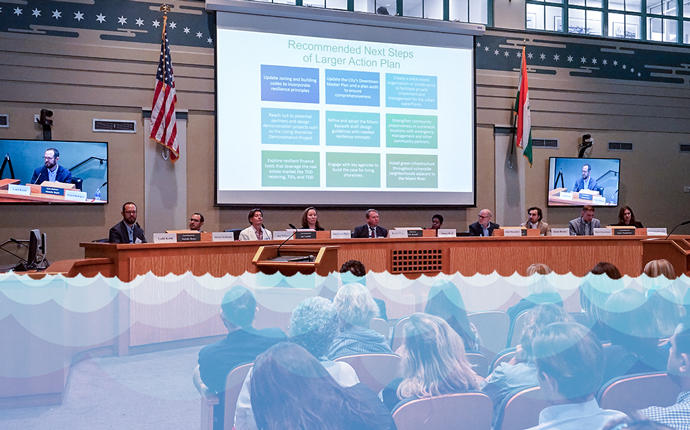UPDATED, June 8, 12:50 p.m.: To cope with rising seas, Miami may have to update zoning and building codes, increase seawall heights, re-write the city’s master plan for downtown with resilience in mind and maybe even transform the FEC slip into a living shoreline pilot project.
Those were some of the recommendations from a panel of 10 experts from the Urban Land Institute, presented to a packed house at the city of Miami’s commission chambers on Friday.
The panel’s broad ranging suggestions offer a glimpse into the adaptations the region will have to make if it wants to live with the two extra feet of water that are projected to arrive by 2060.
The ULI experts spent a week coming up with ideas for making Miami’s urban waterfront more resilient to the shocks and stresses of a changing climate, at the request of the city and the Downtown Development Authority.
“There are no silver bullets for the challenges facing the city of Miami,” said Ladd Keith of the University of Arizona and the advisory panel’s chairperson.
One theme unified the adaptation initiatives: changing how Miami thinks about its relationship with water. “This is a city in and from the water,” said panel member Michael Rodriguez of CBRE, a Miami native.
Suggestions for transforming that relationship include re-tooling the Miami Baywalk designs for increased resilience, and the controversial idea of building living shorelines out into Biscayne Bay.
John Macomber of Harvard business school posed a multi-billion dollar question: “How do we pay for all of this?” His resilience investment scenarios made a case for looking at investments that could reduce uninsured losses.
At the investor and homeowner level, Jason Bonnet of Brookfield Properties noted that flood insurance rates are only expected to increase as the National Flood Insurance Program switches over to risk-based assessment. But he believes that Miami has the chance to “bring confidence to markets by being a leader” through the alteration of its building codes.
The panel made clear that the challenges of adapting Miami’s urban waterfront to the age of climate change are vast. “It’s going to take much more than a village to realize this vision for an accessible, resilient waterfront,” said Jane Gilbert, the city of Miami’s chief resilience officer.”
But the task, according to Keith, is not intractable. “People from the outside may look in and say we’ll be the next Atlantis, but it’s not the case at all.”
Correction: An earlier version of this story incorrectly stated that Ladd Keith works for Arizona State University.
